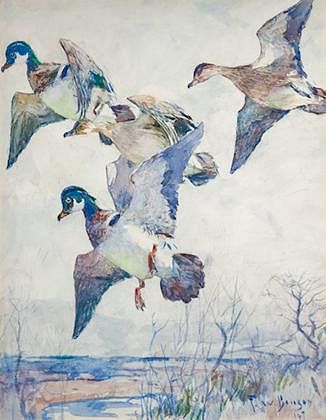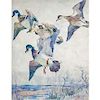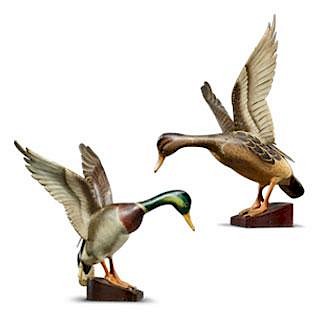Frank W. Benson (1862-1951) Wood Duck
About Seller
20 Winter Street
Pembroke, MA 02359
United States
Founded in 2005, Copley Fine Art Auctions is a boutique auction house specializing in antique decoys and American, sporting, and wildlife paintings. Over the course of the last two decades, the firm has set auction records for not only individual decoy makers, but also entire carving regions. Copley...Read more
Two ways to bid:
- Leave a max absentee bid and the platform will bid on your behalf up to your maximum bid during the live auction.
- Bid live during the auction and your bids will be submitted real-time to the auctioneer.
Bid Increments
| Price | Bid Increment |
|---|---|
| $0 | $50 |
| $1,000 | $100 |
| $2,500 | $250 |
| $5,000 | $500 |
| $10,000 | $1,000 |
| $25,000 | $2,500 |
| $50,000 | $5,000 |
About Auction
Feb 17, 2017 - Feb 18, 2017
Copley Fine Art Auctions cinnie@copleyart.com
- Lot Description
Frank W. Benson (1862-1951)
Wood Duck, 1937
signed and dated "F.W. Benson '37" lower right
watercolor, 26 by 20 1/4 in.
Frank W. Benson first became famous as a creator of plein air impressionist paintings. His later etchings and paintings of birds brought him similar renown. Benson’s impressionist works and striking compositions of wildfowl and upland birds earned him numerous awards. By the time he was sixty, he had become known as “America’s most medaled artist.”A native of Salem, Massachusetts, Frank Benson grew up hunting and fishing with his brothers and cousins in the nearby marshes of Essex County. When he was given a small boat at age twelve, Benson began to explore the waters near his home, carefully studying the birds and their environment. He was fascinated by ornithology and spent long hours wandering the halls of Harvard’s Museum of Comparative Zoology, drawing specimens, and pouring through the library’s thick volumes of natural history. On one visit, young Frank made so many sketches that he ran out of paper. His family treasures his study of a duck, drawn on a piece Museum stationery, perhaps given to him by a professor who admired the boy’s enthusiasm.It is not surprising that Benson’s first oil paintings were of a rail and a snipe brought back from a hunting trip and nailed to a barn door. Benson then portrayed them, in the words of a later critic, “with stark and youthful realism.” [1]He had originally planned to be an ornithological illustrator in the manner of Audubon, but two years at the Académie Julian in Paris inspired him to broaden his focus. In mid-career Benson returned to his first love, birds. In addition to depicting them in oil, watercolor, wash, etching, and drypoint, he diligently worked to support organizations that fostered stewardship of the land and conservation of its resource. A founder of the Essex County Ornithological Society, Benson formed lasting friendships with fellow birders.One of these was William Brewster, a noted ornithologist, who was the curator of mammals and birds at Harvard’s Museum of Comparative Zoology for almost thirty years. He was also the first president of the Audubon Society. The society was founded in 1895 by Harriet Hemingway, the wife of one of Benson’s closest friends, Augustus. Benson immediately donated several paintings to the new organization to benefit the group’s work. It is no surprise that Benson was chosen to illustrate Concord River, a collection of excerpts from the diaries and field notes that Brewster left to Harvard when he died in 1913. (A copy of the book accompanies this lot.[2]) Benson’s handsome watercolor, Wood Duck, is the frontispiece.The ornithologist in Benson is evident in the care with which he deliberately shows the plumage of both the male and female ducks and poses each bird in a different attitude of flight. And yet, arranged against a pale winter sky, the birds appear natural; the composition is not contrived. As Roger Tory Peterson once noted, “Audubon painted bird portraits – stiff, exact, unnatural -- but Benson painted bird pictures.” [3]Benson contributed eleven other illustrations to Brewster’s book, one of which, an image of a wedge of Canada geese, was used on the dust jacket of Concord River. Benson loaned this black and white wash “with characteristic generosity,”[4] to sculptor Daniel Chester French to aid him in the creation of his double-sided Brewster medal. The medal is given to outstanding contributors to the field of ornithology. Frank W. Benson was awarded one of the first two.We are grateful to Frank W. Benson scholar Faith Andrews Bedford, who has written extensively on the artist. Her books include Frank W. Benson American Impressionist(Rizzoli), The Sporting Art of Frank W. Benson (David R. Godine), and Impressionist Summers: Frank W. Benson’s North Haven (Rizzoli/Skira).Endnotes:[1] Samuel Chamberlain, “Frank W. Benson--The Etcher,” Print Collector’s Quarterly, 25, no. 2 (April 1938), p. 167.[2] The first volume of Brewster’s field notes, October Farm, was published by Harvard in 1936.[3] Faith Andrews Bedford, Frank W. Benson: American Impressionist (New York, Rizzoli, 1994), p. 136.[4] William Brewster, Concord River (Cambridge, MA, Harvard University Press), p. vi.PROVENANCE: Private Collection, Dover, Massachusetts
Private Collection, Wellesley, MassachusettsLITERATURE: William Brewster, "Concord River," Cambridge, MA 1937,p. III, illustrated.
Condition
Condition report requests can be made via email or by telephone (info@copleyart.com or 617.536.0030). Any condition statement given is a courtesy to customers, Copley will not be held responsible for any errors or omissions. The absence of a condition statement does not imply that the lot is in perfect condition.
- Shipping Info
-
Shipping info
Copley Fine Art Auctions does not handle the shipping of any items. Shipping is the sole responsibility of the buyer. Once your payment has cleared, and we have received your authorized shipping release form items may be released for shipment. Copley Fine Art Auctions, LLC shall have no liability for any loss or damage to such items. Buyers should allow up to four weeks for shipment.PLEASE BE AWARE THAT INTERNET BIDDERS MAY NOT PICK UP THEIR ITEMS AT THE SALE SITE. ITEMS CAN BE PICKED UP BY APPOINTMENT OR SHIPPED STARTING FIVE DAYS AFTER THE CONCLUSION OF THE SALE
-
- Buyer's Premium



 EUR
EUR CAD
CAD AUD
AUD GBP
GBP MXN
MXN HKD
HKD CNY
CNY MYR
MYR SEK
SEK SGD
SGD CHF
CHF THB
THB













